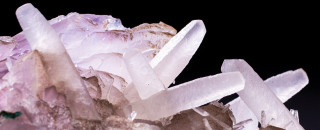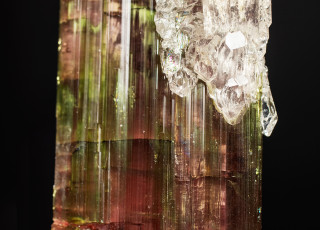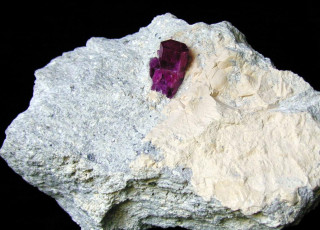What is Calcite
By Dave Richerson
Calcite, CaCO3, is a very common mineral that is popular in private collections and museums. Beautiful crystals are found worldwide in sedimentary rocks, igneous basalt and most ore deposits. An early discovery of calcite was at Eskifjord, Iceland in basalt where a single crystal 7x7x2 meters weighing 250 tons was reported. Transparent, colorless optical quality calcite is often referred to as “Iceland spar”.
The mineral name “calcite” is credited to Gaius Plinius Secundus (Pliny the elder) in the year 79 based on the Latin word for “lime”. Limestone and marble are comprised primarily of CaCO3 as are the shells of most marine organisms. Water often contains much dissolved calcium that can react with carbon dioxide to precipitate calcite. A good example is the formation of stalactites and stalagmites in caves. Image 1 shows a calcite cave formation that was found in a cave near Naica, Chihuahua, Mexico during a mining operation.
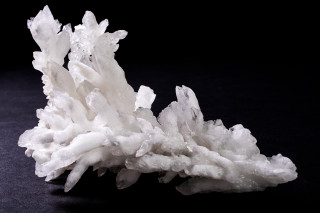
Image 1 Calcite cave formation from near Naica, Chihuahua, Mexico (UMNH-MC 3972) Photo by Mark Johnston
The chemical and physical characteristics of calcite make it relatively easy to distinguish from other minerals. It is relatively soft and can be easily scratched with a knife, having a Mohs hardness of 3. For comparison, quartz has relative hardness of 7, talc of 1, gypsum of 2 and topaz of 8. Crystals of calcite have distinct trigonal (hexagonal) crystal form and perfect cleavage in three directions (to form a rhombohedral shape). Calcite dissolves easily in weak acids including vinegar and gives off bubbles of CO2. A very special characteristic of transparent calcite is birefringence (double refraction). A line viewed through the crystal will appear double.
One characteristic that makes calcite so interesting to collectors is the variety of crystal habits. Some natural calcite crystals have more facets (crystal faces) than the Hope diamond! Around 800 different crystal habits have been reported. A fun activity is to go to Mindat.org and search calcite. There you can look at line drawings of many of the crystal habits and rotate the images so you can really observe the facets. Even more fun, you can click on the photo gallery for calcite where currently 29,530 spectacular photos of calcite crystal clusters from around the world can be viewed.
NHMU's collection has many calcite specimens from around the world. The exhibits on the third floor open to the public every day include calcite twins, colorless calcite crystals with beautiful green dioptase crystals and even a cluster of double-terminated calcite crystals completely filled with sand inclusions. The 45-drawer study collection in the Earth Lab has many other calcite specimens that the visitor can examine close up. Many additional calcite specimens are in drawers in the collections area where they can only be viewed by special appointment. The objective of this article is to show some of these specimens that illustrate different crystal habits and associations with other minerals.
One of the most fascinating forms of calcite is the scalenohedron, often referred to as “dog tooth calcite”. Image 2 shows a large specimen of calcite (approximately 30 cm across) with relatively simple scalenohedrons without a lot of facets. The largest crystals with points on both ends are actually twins consisting of two crystals that are mirror images of each other.
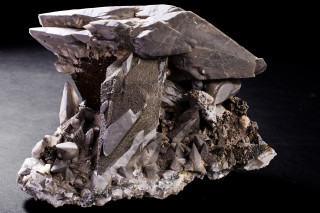
Image 2 Tapered scalenohedral habit calcite crystals from Reynolds Co., Missouri (UMNH-MC 3999). Photo by Mark Johnston
Often, scalenohedral calcite crystals have many facets on the ends and edges of the crystals. The wide variation in these facets account for many of the crystal habit variations of calcite, providing nearly endless variety for collectors to enjoy. Images 3 and 4 show an example of modified scalenohedral calcite crystals from Frizington, England.
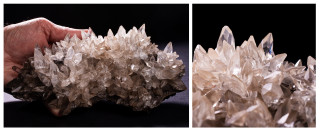
Images 3 and 4 Scalenohedral (dog tooth habit) calcite crystals from Frizington, England (UMNH-MC 2188). Note all the extra crystal faces on the sides and ends of each crystal. Photo by Mark Johnston
Another common crystal habit of calcite is the rhombohedron. Image 5 shows a cluster of reddish calcite rhombohedral crystals from the famous mines at Tsumeb, Namibia. NHMU's collection contains some of the best specimens of any museum of minerals from Tsumeb, many of which are on display in the third floor exhibits. If you have an opportunity to visit the Museum, see how many of the spectacular specimens from Tsumeb you can find.
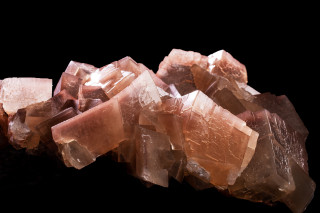
Image 5 Cluster of rhombohedral calcite crystals from Tsumeb, Namibia (UMNH-MC 0268) Photo by Mark Johnston
Since calcite forms in the trigonal (hexagonal) crystal system, the crystals often have a six-sided crystal habit. Images 6 and 7 illustrate a crystal cluster from the Hartz Mountains, Andreasburg, Germany that shows the six-sided hexagonal crystal habit. Note that these crystals are tabular rather than elongated and are stacked. This crystal habit is often referred to as “poker chip” or “potato chip”.

Images 6 and 7 “Poker chip” or “Potato chip” habit of calcite comprised of stacked tabular crystals with a hexagonal outline (UMNH-MC 2276); from the Hartz Mountains, Andreasburg, Germany. Photo by Mark Johnston
One of the most common forms of calcite is elongated (prismatic) crystals with long prism faces and short termination faces. An example from Chihuahua, Mexico is illustrated in Images 8 and 9.
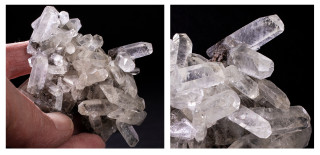
Images 8 and 9 Elongated hexagonal calcite crystals from Chihuahua, Mexico (UMNH-MC 3079) Photo by Mark Johnston
Calcite, especially from ore deposits, is often associated with other minerals such as fluorite, pyrite, galena and sphalerite. Calcite usually deposited over the top of the other minerals as illustrated in Images 10 and 11.
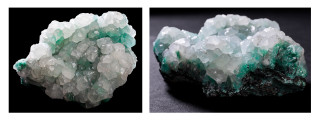
Images 10 and 11 Calcite crystals that have grown over the surface of aurichalcite crystals from the Carbonate Mine, Cardiff Fork, Big Cottonwood Canyon, Salt Lake County, Utah (UMNH-MC 2216) Photo by Mark Johnston
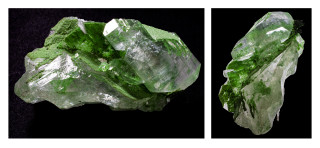
Images 12 and 13 Calcite with inclusions of duftite, Tsumeb, Namibia (UMNH-MC 1201) Photo by Mark Johnston
In addition to inclusions, color variation can occur in calcite due to the presence of impurities. For example, manganese can substitute for some of the calcium to produce a pink or rose color; copper can result in green; iron can result in yellowish or golden; and cobalt can result in dark pink to purple. Image 14 shows another calcite specimen from Tsumeb, Namibia. This specimen has cobalt replacing some of the calcium and is referred to as cobaltoan calcite.
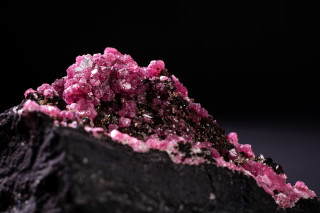
Image 14 Cobaltoan calcite from Tsumeb, Namibia (UMNH-MC 1012) Photo by Mark Johnston
This article has provided just a very small glimpse of the variety and beauty of calcite. You can always learn more in a visit to the Natural History Museum of Utah or any other museum that exhibits a mineral collection. If you are not able to visit a museum, consider buying or finding a book on minerals at your local library, or check out the calcite illustrations and photos at a website such as Mindat.org.
Learn more about mineralogy at NHMU.
Dave Richerson is a retired associate professor of material science and engineering at the University of Utah. He is the author of the books "Modern Ceramic Engineering" and "The Magic of Ceramics," co-author or co-editor of five other books, and author or co-author of more than 100 technical and educational articles and reports. NHMU is part of the University of Utah in Salt Lake City. Our mission is to illuminate the natural world and the place of humans within it. In addition to housing outstanding exhibits for the public, NHMU is a research museum. Learn more.
